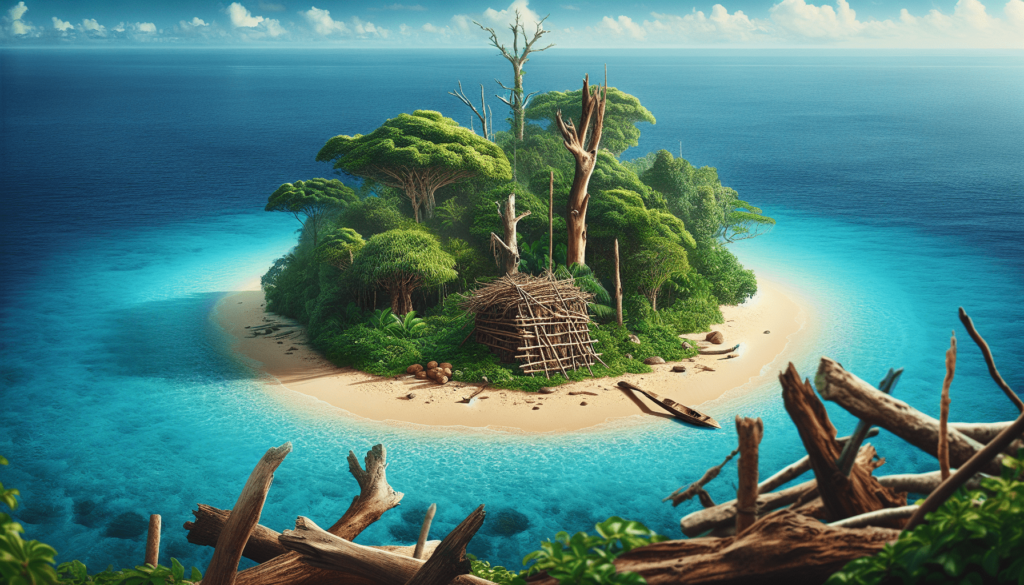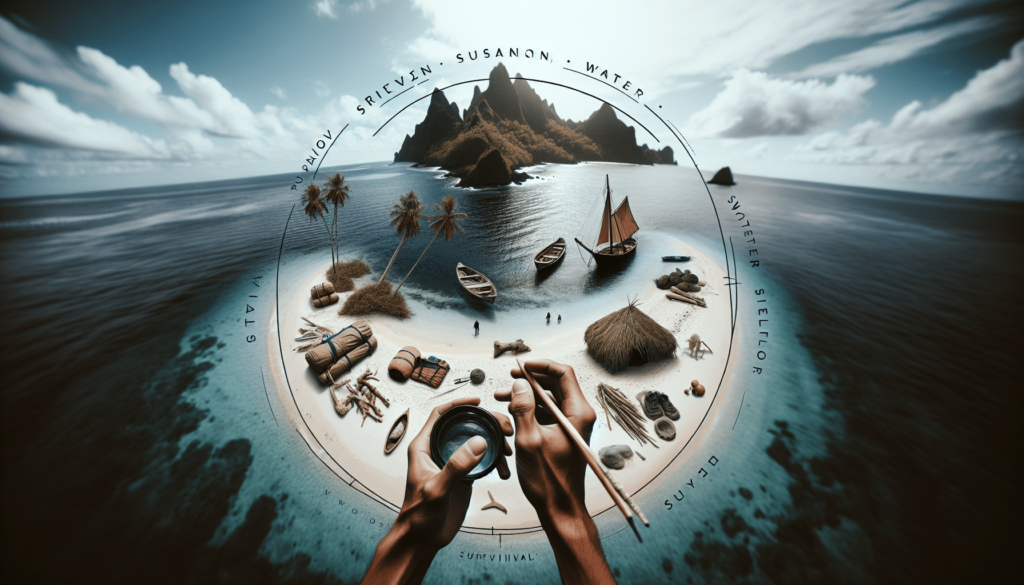Welcome to “The Survivalist Handbook,” your one-stop resource for all things wilderness survival. In this article, we will explore the crucial skills needed to survive on isolated shores. Whether you find yourself stranded on a desert island or simply want to be prepared for any adventure, knowing how to find food, water, and shelter is essential. With our comprehensive collection of articles, you’ll learn valuable techniques and useful tips for thriving in the wilds. So get ready to embark on an exciting journey of island survival and master the art of living off the land in even the most remote locations.
Introduction
Welcome to “The Survivalist Handbook”! In this article, we will explore the importance of island survival skills and provide you with an overview of finding food, water, and shelter on isolated shores. Whether you find yourself on a deserted island by choice or circumstance, it’s crucial to have the knowledge and skills to survive. By understanding the island environment, assessing available resources, and learning key survival strategies, you can increase your chances of thriving in this challenging setting.
1. Understanding the Island Environment
Before diving into survival techniques, it’s essential to understand the island environment. Climate and weather conditions play a significant role in determining the availability of resources and the challenges you may face. Islands can experience extreme temperatures, unpredictable weather patterns, and strong winds, so it’s vital to be prepared for these conditions.
There are various types of islands, each with its own characteristics and unique challenges. Some islands may be small and isolated, while others may have more diverse ecosystems and resources. Understanding the type of island you find yourself on can help you better navigate and survive within its specific environment.
Islands present both challenges and opportunities for survival. While they may lack the resources of mainland environments, they often offer a concentrated and diverse range of flora and fauna. By adapting to the unique challenges and leveraging the available opportunities, you can increase your chances of finding food, water, and shelter in these isolated shores.

2. Assessing Available Resources
To survive on an island, it’s crucial to identify the resources available to you. Edible plant life is an essential source of sustenance. Learn to identify native plants that are safe for consumption and those that may be toxic. This knowledge will enable you to gather food without putting yourself at risk.
Finding sources of fresh water is another top priority. On an island, water may be scarce, so it’s vital to identify potential freshwater sources such as streams, springs, or even natural reservoirs. Developing skills to collect and store rainwater can also help ensure a steady water supply.
Scouting for potential shelter locations is critical for protection from the elements. Islands may offer various options for shelter, such as caves, large rock formations, or dense vegetation. Assessing the available resources and natural features can help you identify suitable locations for building a shelter.
3. Gathering Food
When it comes to island survival, you must learn various techniques for gathering food. Fishing is an effective method that can provide a consistent source of protein. Familiarize yourself with different fishing techniques, such as using improvised fishing gear or constructing traps, to increase your chances of success.
Foraging for edible plants is another vital skill. Learn to identify edible plants that are safe to consume and have nutritional value. Practice distinguishing them from potentially toxic plants to avoid any harmful consequences. Being able to find and utilize these natural resources can significantly supplement your food supply.
In addition to fishing and foraging, hunting small game can provide additional sustenance. Learn trapping techniques and practice setting up snares or constructing rudimentary weapons to catch smaller animals like birds or rodents. However, it’s essential to respect the local ecosystem and follow any regulations to ensure sustainable hunting practices.

4. Obtaining Clean Water
Ensuring a reliable source of clean water is paramount to your survival on an island. Collecting rainwater is a straightforward and effective method. Set up catchment systems using containers or natural formations to collect rainwater during storms. Remember to purify the water before consumption to remove any potential contaminants.
Finding natural freshwater sources such as streams or springs can be challenging, but they provide a more sustainable water supply. Learn to identify the signs of freshwater, such as the presence of certain plant species or animal activity near water sources. Develop the skills to navigate the terrain and locate these hidden water sources.
If clean water is not readily available, you must understand purification methods. Boiling water is a reliable method to kill bacteria and other harmful microorganisms. Additionally, filters or purification tablets can be used to ensure water is safe to consume. Having the necessary tools and knowledge to purify water can be lifesaving in a survival situation.
5. Building Shelter
Creating a sturdy and protective shelter is crucial for your safety and well-being. Utilize natural materials found on the island, such as branches, leaves, and rocks, to construct a shelter that will shield you from the elements. Consider the island’s unique environmental conditions and build a shelter that can withstand high winds, heavy rainfall, or intense heat.
Ensuring your shelter is waterproof is essential, especially during rainy or stormy weather. Use various techniques such as layering leaves or using tarps to create a barrier against water. Properly insulating your shelter can also help regulate temperature, keeping you warm during cold nights and cool during hot days.
In addition to the shelter itself, creating a fire pit is essential. A fire serves multiple purposes, from providing warmth and cooking food to offering a sense of security. Utilize rocks or dig a hole to construct a fire pit, ensuring it is in a safe location and away from any flammable materials. Collect dry wood and other fire-starting materials to have readily available for emergencies.
6. Fire Starting Techniques
Starting a fire is a fundamental skill for survival in any environment, and it is especially critical on an island. Having the ability to start a fire can provide warmth, protection, and a means for cooking food.
Carrying a fire starter kit, such as waterproof matches or a fire striker, can significantly increase your chances of successfully starting a fire. Practice using these tools before heading to the island to familiarize yourself with their operation and ensure they are in working condition.
Friction-based fire starting methods, such as using a bow drill or a hand drill, can be employed as alternative methods to start a fire. These techniques require practice and skill, but they can be valuable when your resources are limited.
Recognize the importance of fire for survival, as it can provide comfort, light, and the ability to purify water. Practice fire starting techniques regularly to enhance your skills and confidence in challenging situations.
7. Navigating the Island
Navigating the island is crucial for exploring and locating resources. Orientation using natural landmarks, such as mountains, tall trees, or coastal formations, can help you maintain your bearings. Identify prominent landmarks and use them as reference points while navigating the island.
Celestial navigation can be another useful method for finding your way. Learning to read the stars and using them as a guide during the night can help you determine your general direction of travel.
In the absence of modern navigation tools, you can also create improvised tools to aid with navigation. For example, using a simple sundial or an improvised compass can assist in establishing direction and provide a sense of control over your movements.
8. Signaling for Rescue
In a survival situation, your ultimate goal may be to signal for rescue. Building a signal fire is one of the most effective ways to attract attention from potential rescuers. Choose a visible location, gather highly flammable materials, and create a large, dense smoke signal. Ensure you have a plan in place for keeping the fire going and maintaining a steady stream of smoke.
Crafting effective signaling devices can also increase your chances of being spotted. Items such as mirrors, bright-colored clothing, or signal flags can be used to reflect light and draw attention to your location. Practice using these devices to maximize their effectiveness.
Developing a distress signal plan is essential to communicate your need for help effectively. Establish specific patterns or signals that are easily recognizable and understood by potential rescuers. Having a well-thought-out signal plan can significantly increase the chances of being rescued in a timely manner.
Conclusion
In conclusion, island survival requires a combination of knowledge, skills, and preparedness. By understanding the island environment, assessing available resources, and learning key survival strategies, you can enhance your chances of finding food, water, and shelter on isolated shores. Remember, preparation and practice are crucial for mastering island survival skills. So go out there, explore, and be ready to thrive in any wilderness environment. Stay safe, and happy surviving!

